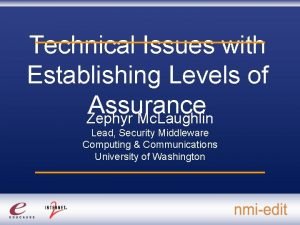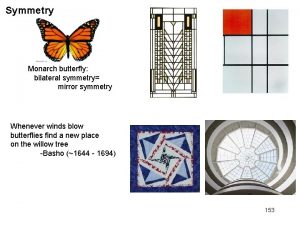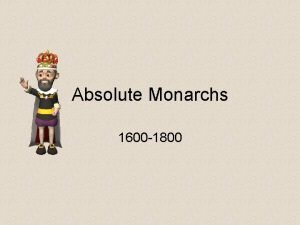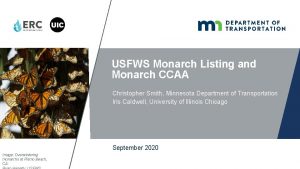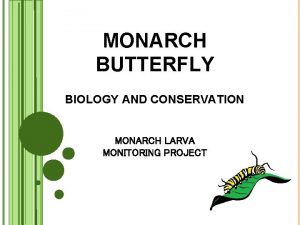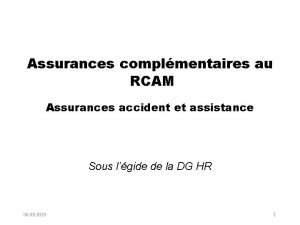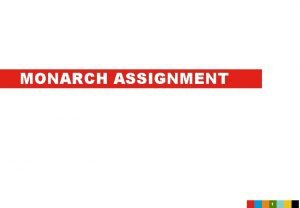Candidate Conservation Agreement with Assurances CCAA For Monarch










- Slides: 10

Candidate Conservation Agreement with Assurances (CCAA) For Monarch Butterfly on Energy and Transportation Lands

Short Background Collaboration between University of Illinois at Chicago and U. S. Fish and Wildlife Service and more than 30 other entities from the Energy and Transportation sectors. The Eastern Monarch Butterfly population has declined by 80% over the last 20 years The species may be listed as endangered or threatened in the near future (Dec. 2020) Minnesota is considered summer breeding habitat in the Eastern Monarch migration. Key threats to habitat loss: Land Conversion Herbicide Use Mowing

Suitable Habitat - Habitat for Monarchs that consists of lands that provide milkweed and are suitable for breeding and foraging needs at the times of year when Monarchs are present. KEY Definitions Enrolled Acres - Land (owned, leased, managed easements, permitted) within the covered area and identified by the signed Certificate of Inclusion of all Parties. Eligible lands for enrollment include any non-Federal or Federal lands within the covered area on which conservation measures or covered activities may occur. Adopted Acres – Adopted acres are those lands within the enrolled lands where conservation measures are used to create, enhance, restore, sustain, or maintain habitat that supports monarch butterfly breeding and/or foraging requirements as documented by effectiveness monitoring. For Stearns County, this would be 5% of the total enrolled acres (Adoption Rate). Assurances – On non-Federal lands, Partners receive assurance from the “Service” that additional conservation measures above and beyond those contained in the Agreement will not be required for monarch butterflies, and that additional land, water, or resources use limitations will not be imposed upon them, on enrolled lands, should the species become listed in the future.

What Enrolled VS Adopted ROW Looks Like for Stearns County • Approximately 970 CL Miles of County Roads (Paved and Gravel) • Equates to ~ 7524 acres of road Rights-of-Way that would be “enrolled” in the CCAA • 5% of the 7524 acres would be “adopted” and managed as Monarch butterfly habitat. • 376. 2 acres of adopted habitat

Conservation Methods Likely Required on Adopted Acres • Defer mowing/haying activities 1. Before May 15 th 2. From June 30 th to July 5 th 3. After September 20 th • Localized herbicide treatment of noxious/invasive weeds versus broadcast treatments • Clearing of woody plants and brush as needed to maintain “early succession” habitat

Monitoring Provisions The partner will be responsible for tracking and reporting compliance Dates/Times and locations for implementing conservation measures Mapping of planting/prescribed burns and herbicide treatment areas Randomized plot sampling/stem counts ( 6 per 1500 SQFT plot) Reporting of maintenance activities within the adopted acres and subsequent conservation efforts.

Covered Activities on Enrolled Acres Infrastructure maintenance includes structural repairs, replacement, and maintenance. This includes, but is not limited to, guyed wire replacement, culvert replacement, pole wrapping or painting, gas leak repairs, structural testing and treatments, above and below ground structural replacements, and woodpecker assessments and patching. This also includes pavement repair, mill and overlays, shoulder repairs, painting and striping, guardrail installation or replacement, signage and lighting installation or replacement, manhole/inlet cleaning, installation and maintenance of curb and gutter, culverts, bridges and piers, scour aprons, cattle grates, and similar structures.

Cost Analysis 1. Application and administration fees through UIC 2. Project development and implementation time/materials 3. Karner Blue Butterfly Example, WISDOT 1. Habitat Conservation Plan (HCP) 2. Dec. 1992 Karner Blue Butterfly Listed. 3. Dec. 1994 Initial investment in creating an HCP 4. HCP plan approved in 1999 (5 yrs) 5. WISDOT anticipated administrative cost ~ $18, 000 / year plus additional $20, 000 – $30, 000 for consultant surveys

Will Need to Comply with Section 7(E&T Species) and Section 106 (Cultural Heritage) Through Weak Federal Nexus Stearns Northern long-eared bat Myotis septentrionalis Threatened Townships containing northern longeared bat roost trees and hibernacula links to Minnesota DNR PDF Hibernates in caves and mines swarming in surrounding wooded areas in autumn. Roosts and forages in upland forests during spring and summer.

Pros and Cons for Enrollment Pros Continued County Maintenance and Construction operations on enrolled lands “as normal. ” Maintenance, Construction and Utility activities excluded from further federal permit requirements if the monarch is listed. “Assurances” Cons CCAA fees and cost Up front time/cost in putting together an implementation plan for the CCAA. Time and Material for implementing conservation methods annually Would allow continued cutting and haying of enrolled highway rights of way Cost effective way to mitigate/avoid current and future construction project delays and permitting if the Monarch is listed Would reduce the ability to farm/cut/hay rights of way along the “adopted” roadways. Cutting would be deferred until after sept. 20 th. General restrictions to public on adopted acres (UTV/ATV Use) Agreement does not cover new infrastructure or related activities on newly acquired, or previously undeveloped or unmaintained rights of way Need to have approved application before the Monarch is listed. CCAA creates a “weak federal nexus” which may have an impact on some construction projects and maintenance activities Doing our part to create critical habitat for a species in need. Will increase diversity of other butterfly and plant species within Stearns County Rights of Way.
